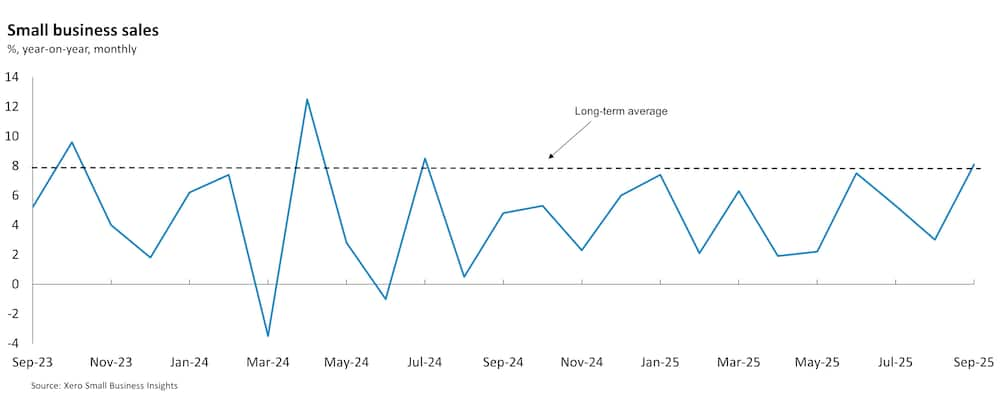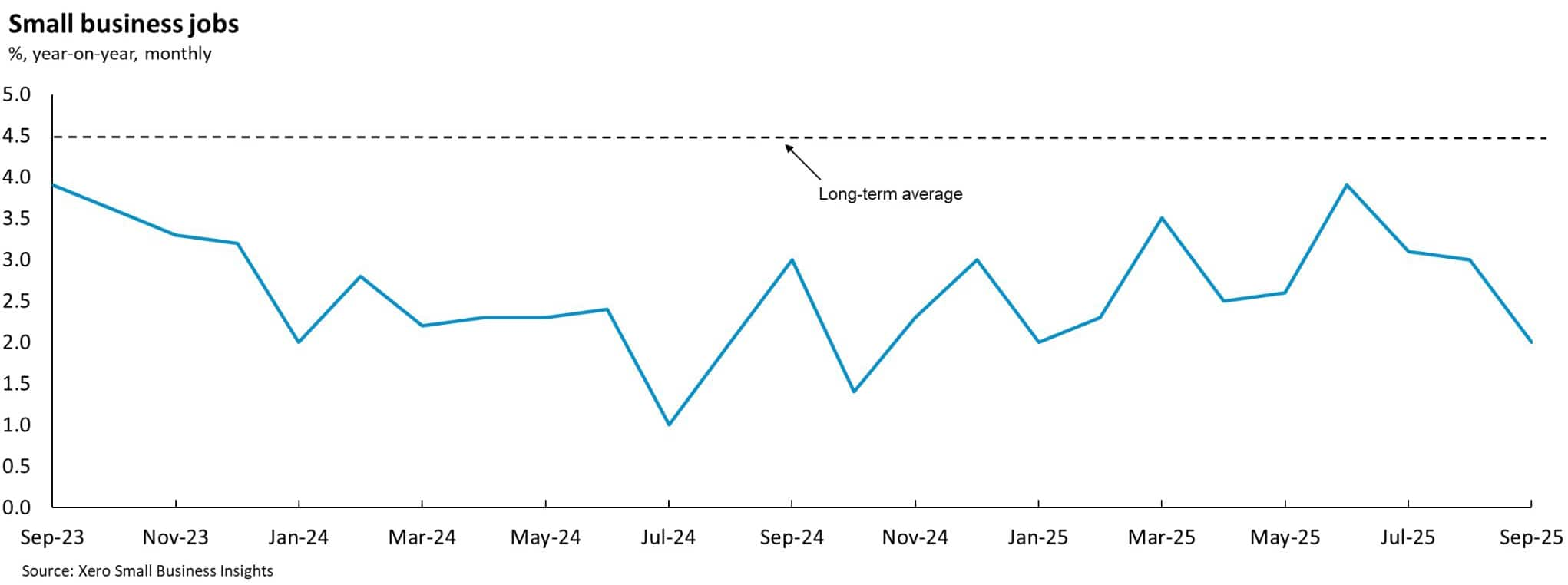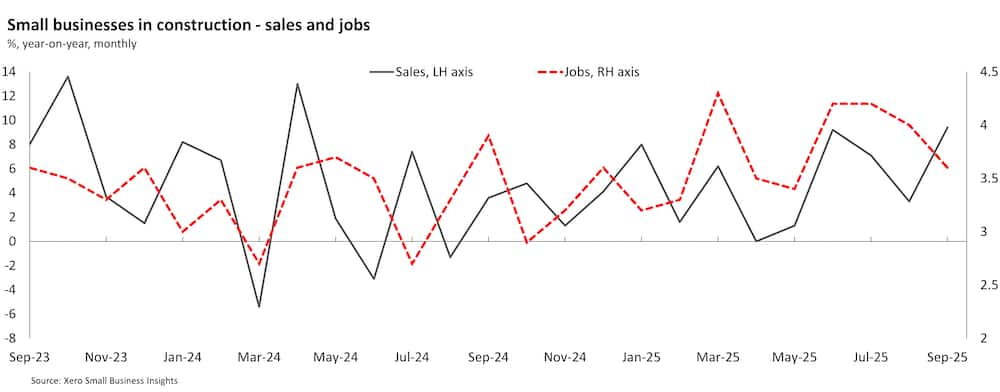Australia Small Business Insights
This analysis focuses on core performance metrics of sales growth, jobs growth, wages growth, and time to be paid.


Positive signs emerging for small business sales
Published: 30 October 2025
The latest Xero Small Business Insights (XSBI) data for Australia shows sales growth picked up in the September quarter, suggesting the benefits of official interest rate cuts may finally be starting to flow to small businesses. Jobs growth has slowed in recent months but is still positive, likely reflecting the lagged impact of soft mid-year sales. Overall, small business conditions are still below average, but this latest data points to some welcome green-shoots for Australian small businesses.
Sales in small businesses grew 5.5% year-on-year (y/y) in the September quarter, following a soft 3.9% y/y rise in the June quarter. The latest quarterly performance is the largest rise in sales in two years. This is a promising result, although sales growth is still below its long-term average of 7.8% y/y. The monthly data shows a continuation of the sales pattern seen earlier in the year, with a spike in sales in September (+8.1% y/y) following the Reserve Bank of Australia's (RBA) cut in the official interest rate in August. These short-term boosts are yet to be sufficient to get sales growth sustainably back above average. However, promisingly the June spike (+7.5% y/y), following the May interest rate cut, did appear to keep going a little longer into July (+5.3% y/y).
The latest XSBI data is consistent with the RBA's media release following the decision to leave the official interest rate on hold in September. The RBA noted that private consumption was picking up, thanks to real wages finally starting to grow, cuts in income tax and the official interest rate and wealth effects from higher house prices. We will need to wait for the next round of data to see if sales momentum can continue into the important summer and holiday period.

Small business conditions are still below average, but this latest data points to some welcome green-shoots for Australian small businesses.
XSBI Australia July 2025 - September 2025 data
Jobs in small businesses grew 2.7% year-on-year (y/y) in the September quarter, after a 3.0% y/y rise in the June quarter. The monthly pattern shows that this slowdown largely happened in the final weeks of the quarter, with jobs rising 3.1% y/y in July, 3.0% y/y in August but only 2.0% y/y in September. Jobs are a lagging indicator, so this September slowdown could reflect the soft sales performance seen earlier in the year. It could also reflect the impact of heightened uncertainty, with business owners reluctant to take on staff when the outlook remains particularly unclear.
Despite the modest slowdown in jobs growth, the share of small businesses growing their workforce increased slightly in the quarter, to 28.8% from 28.5% in the June quarter. The latest result is the highest share since the December quarter 2023. This was offset by a rise in the share of small businesses reducing the size of their workforces, at 24.1% compared to 23.7% in the June quarter.
The latest XSBI results are broadly consistent with a modest slowdown in jobs growth across the Australian economy, as shown in the Australian Bureau of Statistics data. Nevertheless, employment growth remains positive and the RBA continues to characterise the labour market as "a little tight", suggesting it is not yet alarmed by this trend. It could also prove short-lived if the pick up in small business sales is sustained, and even gathers pace, in the coming months.

Regional data showed a broad-based improvement in sales, but less positive news for jobs in the September quarter. Particularly welcome is the improvement in Victoria, where sales grew 4.7% y/y after a tepid 2.5% y/y rise in the June quarter. The surprising standout performer in the quarter was Tasmania, which is often an under-performer. Sales grew 6.7% y/y in the September quarter, up from 2.4% y/y in the June quarter and the strongest performance for the state in over two-and-a-half years. Jobs data was less positive than sales, with all regions reporting smaller gains than in the June quarter. The largest rises were Western Australia (+3.9% y/y) and Queensland (+3.5% y/y).
Industry data shows the improvement in sales was broad based, with 15 of the 17 industries tracked recording stronger sales growth than in the June quarter. This is in contrast to earlier in the year when industries linked to public funding, such as health and public administration, were offsetting softer performances from other industries. Of particular note this quarter is construction, where sales grew 6.6% y/y (the largest rise in two years) and jobs rose 3.9% (the second strongest industry this quarter and the best result in two years). These are positive signs and important for the broader economy, given the strong multiplier links construction has with other sectors such as retail trade, real estate services and financial services. Retail trade sales grew 4.8% y/y and jobs grew 2.4% y/y. These results are both similar to the June quarter outcomes but are stronger than this time last year, when interest rate cuts were yet to start. Hospitality sales rose 4.5% y/y, up from 3.2% y/y in the June quarter. However, jobs growth in this industry remains tepid - down 0.5% y/y in the September quarter - the seventh decline in jobs in the past eight quarters.

Looking ahead, it is still too early to declare Australia has been able to achieve a "soft landing" i.e. return inflation to target without going into recession or substantially increasing unemployment. Nevertheless, this latest XSBI data release is part of a growing pile of evidence to suggest that this outcome has been secured. This is a rarity that, if future data supports it, should be celebrated. On a more cautious note, small businesses are still facing challenging conditions and, by historical standards, sales and jobs growth have not yet fully recovered. The heightened levels of uncertainty that have dominated the macroeconomy this year have eased but not completely disappeared.
The "green-shoots" evident in the latest XSBI data make the upcoming holiday and summer period even more important than usual, especially for consumer-facing small businesses. It is a great reminder to everyone about the importance of supporting local small businesses when considering purchases over the coming months.
For more information on the XSBI metrics, see our methodology page.
Note on XSBI jobs metric
The COVID-19 pandemic caused significant volatility in many datasets, including XSBI. To account for this the XSBI jobs data series previously had a 'COVID-19 adjustment' made to it. Sufficient time has now passed since the end of the pandemic period to remove this temporary adjustment. As a result, historical XSBI jobs growth data has been subjected to larger than usual revisions in this latest publication.
Disclaimer
This report was prepared using Xero Small Business Insights data and publicly available data for the purpose of informing and developing policies to support small businesses.
This report includes and is in parts based on assumptions or estimates. It contains general information only and should not be taken as taxation, financial, investment or legal advice. Xero recommends that readers always obtain specific and detailed professional advice about any business decision.
The insights in this report were created from the data that was available as at the date it was extracted. Data used was anonymised and aggregated to ensure individual businesses can not be identified.
Contact us about Xero Small Business Insights
Arming small business owners with simple but powerful insights. If you have any questions, reach out to us.